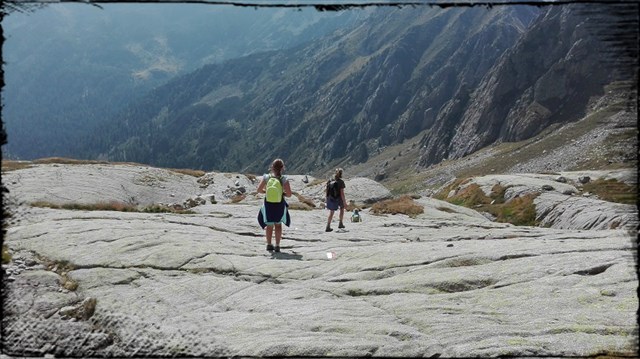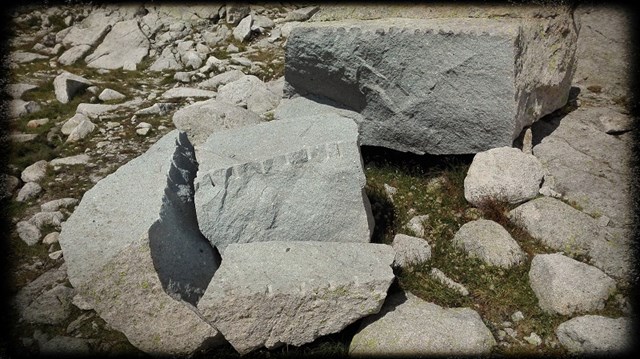
La Valsugana rappresenta dal punto di vista geologico il limite meridionale di una vasta area denominata Piattaforma Porfirica Atesina. Questa regione è composta da rocce classificate come porfidi quarziferi e si estende dalla Val Gardena - Merano a nord fino alla Valle del Vanoi e Valsugana a sud. Originata dalla intensa attività vulcanica circa 270 milioni di anni fa rimase poi sommersa sotto il mare " Tetide" per milioni di anni per poi sollevarsi circa 20 / 25 milioni di anni fa (orogenesi alpina). La sua formazione è costituita da rocce di tipo effusivo, intrusivo e metamorfico. Le rocce rivestono grande interesse geologico essendo in gran parte formate dal consolidamento di lave circa 270 milioni di anni fa.
La catena del Lagorai è costituita da un tipo di rocce denominato "porfidi quarziferi", composti da una successione di prodotti vulcanici fuoriusciti con estrema violenza e velocità sulla superficie terrestre. Il colore di questo tipo di rocce, la cui età è di circa 270 milioni di anni, è rosso violaceo e molto spesso all'interno sono visibili dei cristalli di quarzo che assomigliano a dei piccoli pezzi di vetro.
Il gruppo di Cima d'Asta in senso stretto è costituito invece da una grossa massa di roccia granitica, derivata dal lento raffreddamento del magma originario all'interno della della crosta terrestre. Il "Granito di Cima d'Asta" ha un'età di circa 275 milioni di anni ed è formato prevalentemente da cristalli di ortoclasio e quarzo (cristalli chiari) mentre i caratteristici cristalli scuri sono in prevalenza di biotite.
Esistono due teorie sulla formazione delle rocce granitiche, che da decenni oppongono gli studiosi di Geologia che a seconda della teoria abbracciata si dividono in "Magmatisti" e "Trasformisti" Secondo i primi i graniti hanno origine per consolidamento di un magma, intruso allo stato almeno parzialmente fluido in rocce preesistenti. Secondo i "Trasformisti", invece, tali rocce sono state prodotte da una trasformazione metasomatica di rocce preesistenti, avvenuta essenzialmente allo stato solido.
Il particolare aspetto delle rocce di queste montagne fornisce anche il nome ad un bel giro ad anello, della durata di tre giorni, detto per l'appunto "Alta via del granito", di cui il laghetto di Cima d'Asta costituisce una delle tappe intermedie.

Come loggare questa cache
Ti ricordo che questa è una Earthcache e quindi non vi è alcun contenitore da cercare. Per loggare questa cache dovrai semplicemente rispondere alle domande di seguito. Non scrivere le risposte nel log, ma inviale al mio profilo tramite www.geocaching.com. Inviate le risposte puoi fare subito il log, senza aspettare la conferma; se le tue risposte sono sbagliate verrai contattato.
A. Alle coordinate del WP1 ti troverai di fronte ad un blocco di granito spezzato in quattro grosse parti (vedi foto sopra). Sulle pareti dei blocchi spezzati è possibile apprezzare la struttura granulare tipica del granito di Cima d'Asta. Si tratta di una roccia di colore grigio chiaro con struttura cristallina a grana media, con frequente presenza di grossi cristalli isolati di K-feldspato e la presenza di noduli scuri di concentrazione femica a vario sviluppo e di forma per lo più rotondeggiante od ovoidale. Stima la quantità di queste macchie anomale di colore scuro sulle pareti di recente frattura del masso (meno di dieci / tra dieci e venti / più di venti).
B. Il granito di Cima d'Asta è una roccia di tipo effusivo o intrusivo? Sapresti dare una veloce spiegazione sulla formazione di questo tipo di rocce?
C. Portati al WP2, ti troverai su una zona chiamata "I Lastoni" (uno dei sentieri che porta al rifugio attraversa proprio in questo punto). Descrivi sommariamente la forma delle rocce granitiche su cui ti trovi. Secondo te a cosa può essere dovuta la loro forma particolare?
D. Opzionale: invia una tua foto al WP2 o davanti ad una masso di granito, potrai partecipare al concorso "Geocacher granitico dell'anno"!
[ENG]
Anyone who has climbed up to Cima d'Asta will have noticed the distinctive appearance of the rock on the path that leads to the refuge Brentari. These are granitic rocks that give to this place a solid appearance and at the same time a spectacular view.
The word granite comes from the Latin Granum (grain), with clear reference to its holocrystalline structure.
Valsugana is the geologically southern limit of a vast area known as Platform Porphyric Atesina. This region is made up of rocks classified as quartz porphyry and extends from Val Gardena - Merano in the north to the Vanoi Valley and Valsugana in the south. Originating from volcanic activity about 270 million years ago was then submerged under the sea "Tethys" for millions of years and then rise about 20/25 million years ago (Alpine orogeny).
The Lagorai group is constituted by a type of rocks called "quartz porphyry", composed of a succession of volcanic products spilled with extreme violence and speed on the terrestrial surface. The color of this type of rocks, whose age is approximately 270 million years, is purplish red and very often are visible inside of the quartz crystals that resemble small pieces of glass.
The group Cima d'Asta consists instead of a large mass of granite rock, derived from the slow cooling of the original magma inside the earth's crust. The "Granite Cima d'Asta" has an age of about 275 million years and consists mainly of orthoclase crystals and quartz (crystal clear) while the characteristic dark crystals are predominantly of biotite.
There are two theories on the formation of granite rocks, which for decades opposed the experts of Geology that according to the theory espoused are divided into "Magmatisti" and "Trasformisti". According to the first granites originated by consolidation of magma, the intruder was at least partially fluid in existing rocks. According to the others, however, these rocks have been produced by a metasomatic transformation of existing rocks, which took place essentially in the solid state.
The particular aspect of the rocks of these mountains also gives the name to a beautiful ring trail, said precisely "Alta via del granito" of which the Brentari hut is one of the intermediate stops.
How to log this cache
I remind you that this is a Earthcache and therefore there is no container to search. To log this cache you can simply answer the questions below. Do not write the answers in the log, but send them through my profile www.geocaching.com. Once sent the answers you can log immediately, without waiting for confirmation; if your answers are wrong you will be contacted.

A. At coordinates of WP1 you will see a block of granite broken into four large pieces (see photo above). On the walls of the blocks broken you can appreciate the typical granular structure of granite of Cima d'Asta. It is a rock light gray crystalline structure with medium grain, with frequent presence of large crystals of K-feldspar isolated and the presence of dark nodules concentration in various form (mostly round or ovoid). Estimate the amount of these abnormal dark stains on the walls of recent fracture of the rock (less than ten / between ten and twenty / more than twenty)
B. The granite of Cima d'Asta is a rock effusive or intrusive? Could you give a quick explanation on the formation of this type of rocks?
C. Go to WP2, you'll find on an area called "Lastoni" (one of the paths leading to the refuge is coming exactly over this point). Describe briefly the shape of granite rocks on which you stand. In your opinion what can be due to their particular form?
D. Optional: send your photo to the WP2 or near a granite rock, you will participate in the competition "Granite geocacher of the year"!